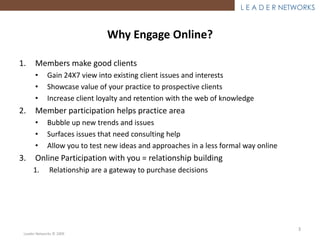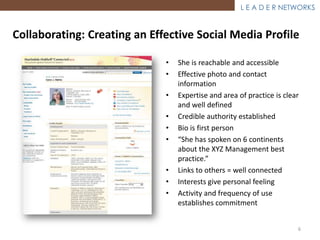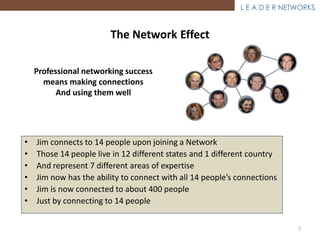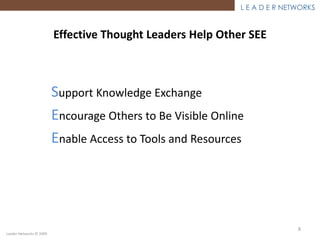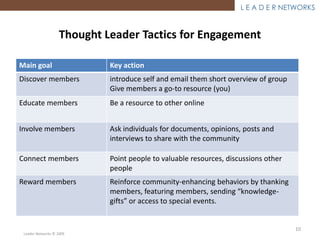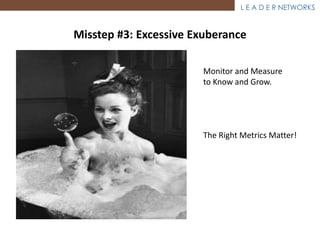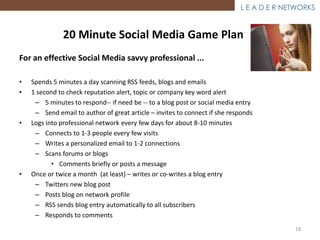How To Be a Thought Leader - Online
- 1. L E A D E R NETWORKS How To Be A Thought Leader Online Vanessa DiMauro CEO, Leader Networks Presented to Institute of Management Consultants 2009
- 2. L E A D E R NETWORKS Professional networking & social media It’s all about connecting online 2
- 3. L E A D E R NETWORKS Why Engage Online? 1. Members make good clients • Gain 24X7 view into existing client issues and interests • Showcase value of your practice to prospective clients • Increase client loyalty and retention with the web of knowledge 2. Member participation helps practice area • Bubble up new trends and issues • Surfaces issues that need consulting help • Allow you to test new ideas and approaches in a less formal way online 3. Online Participation with you = relationship building 1. Relationship are a gateway to purchase decisions 3 Leader Networks © 2009
- 4. L E A D E R NETWORKS Being A Brand Online Online Leadership offers an opportunity for you to develop your “Idea Portfolio” through active participation with people and content over time – Hybrid between published article and verbal presentation i.e. talk or consulting situation – BUT: Big Difference - Exchanges are typically BETWEEN you and another person plus onlookers – Most important thing to get right is how you interact with people online © 2009 Leader Networks 4
- 5. L E A D E R NETWORKS Listening: Reputation Management • Discover your online identity – Research yourself, your firm or company and your area of practice – http://www.google.com/alerts – Fix or edit any incorrect information about you or your firm. • If you find yourself quoted, mentioned or commented about on a blog or article, use comments area to respond – right away Activity + Credibility = Visibility 5
- 6. L E A D E R NETWORKS Collaborating: Creating an Effective Social Media Profile • She is reachable and accessible • Effective photo and contact information • Expertise and area of practice is clear and well defined • Credible authority established • Bio is first person • “She has spoken on 6 continents about the XYZ Management best practice.” • Links to others = well connected • Interests give personal feeling • Activity and frequency of use establishes commitment 6
- 7. L E A D E R NETWORKS The Network Effect Professional networking success means making connections And using them well • Jim connects to 14 people upon joining a Network • Those 14 people live in 12 different states and 1 different country • And represent 7 different areas of expertise • Jim now has the ability to connect with all 14 people’s connections • Jim is now connected to about 400 people • Just by connecting to 14 people 7
- 8. L E A D E R NETWORKS Effective Thought Leaders Help Other SEE Support Knowledge Exchange Encourage Others to Be Visible Online Enable Access to Tools and Resources 8 Leader Networks © 2009
- 9. L E A D E R NETWORKS Facilitation Best Practice for Thought Leaders • Framing a question effectively – Blending inquiry with advocacy • Being a facilitator not an expert knower – Moving tacit knowledge into explicit knowledge • Tone and timing • Talking to yourself • Outreach • Teaching a person to fish – Connecting others – Handing over reigns – Managing a highly involved subgroup 9 Leader Networks © 2009
- 10. L E A D E R NETWORKS Thought Leader Tactics for Engagement Main goal Key action Discover members introduce self and email them short overview of group Give members a go-to resource (you) Educate members Be a resource to other online Involve members Ask individuals for documents, opinions, posts and interviews to share with the community Connect members Point people to valuable resources, discussions other people Reward members Reinforce community-enhancing behaviors by thanking members, featuring members, sending “knowledge- gifts” or access to special events. 10 Leader Networks © 2009
- 11. L E A D E R NETWORKS A Social Media Lifecycle INVITE CONNECT Ask others to Engage with participate in an others and be online discussion a connector topic with you SEARCH Find clients or CONTRIBUTE colleagues who are members of the • Send a link to a story that would be network, identify relevant or interesting to them relationships and • Watch blogs and use the comment feature connect with them • Answer questions in the discussion groups • Feature others on your blog or reference them favorably in the community 11 © 2009 Leader Networks
- 12. L E A D E R NETWORKS "Share your knowledge. It's a way to achieve immortality." -- Dalai Lama 12
- 13. L E A D E R NETWORKS Promoting: Using Social Media to Prospect Or ... How social media are just like being at a face-to-face event Prepared Connected In step with others Graceful 13
- 14. L E A D E R NETWORKS Mis-step #1: Business goals don’t match Social Media Program/Efforts Intention and outcome need to be aligned The WHO should dictate the HOW and the WHY
- 15. L E A D E R NETWORKS Misstep #2: Building Mausoleums instead of Sherpa Tents Evolutionary sprints are key Build, learn, evolve, build, learn, evolve, build
- 16. L E A D E R NETWORKS Misstep #3: Excessive Exuberance Monitor and Measure to Know and Grow. The Right Metrics Matter!
- 17. L E A D E R NETWORKS What You Need to Succeed: the Three P’s • A Purpose for engaging – Know what you want to get out of online professional networking – Define the social media program goals and plans (increase awareness of partners capabilities, share thought leadership) • A Point of View – Use the virtual podium wisely – photo, info & ideas and update – Power to showcase knowledge • let your attorneys show what they know • Transparency is key • If they would be allowed to attend an event without regulation, let them online without controls • Patience – Returns come over time - expect results after 3-6 months. – In person rules of engagement = online rules of engagement 17
- 18. L E A D E R NETWORKS 20 Minute Social Media Game Plan For an effective Social Media savvy professional ... • Spends 5 minutes a day scanning RSS feeds, blogs and emails • 1 second to check reputation alert, topic or company key word alert – 5 minutes to respond-- if need be -- to a blog post or social media entry – Send email to author of great article – invites to connect if she responds • Logs into professional network every few days for about 8-10 minutes – Connects to 1-3 people every few visits – Writes a personalized email to 1-2 connections – Scans forums or blogs • Comments briefly or posts a message • Once or twice a month (at least) – writes or co-writes a blog entry – Twitters new blog post – Posts blog on network profile – RSS sends blog entry automatically to all subscribers – Responds to comments 18
- 19. L E A D E R NETWORKS Presenter’s BIO • Vanessa DiMauro is the CEO of Leader Networks. A pioneer in business-to-business community building, Vanessa has been creating successful online communities and networks for more than fifteen years. Vanessa is a popular speaker, researcher and author on the topics of online communities, social and professional networking, and Web 2.0 for business. With a research background, Vanessa takes the approach of a cultural anthropologist to help businesses effectively use social media to get closer to their customers, generate revenue, innovation and tangible ROI. She has founded and run leading online professional communities such as Cambridge Information Network (CIN) for Cambridge Technology Partners, Computerworld Executive Suite and CXO Systems' Peer Visibility Network. She consults with many organizations on Web 2.0 for business and has a blue chip client list which includes Cisco, Cognizant, EMC, LexisNexis, The Palladium Group and SAP. • Vanessa DiMauro was recently named a 2009 Research Fellow for the Society of New Communications Research and also serves as an Executive- In-Residence at Babson College, for the Olin School of Management. Women in Technology International (WITI) named Vanessa DiMauro one of "Boston's Most Influential Women in Technology". She holds both a B.A. and an M.A. from Boston College. 19
Editor's Notes
- Online networking and using social media can seem to be daunting task – it is everywhere in the media, everyone is talking about it, but the focus has largely been on the teenager sites, and consumer communities. However, online networking is not just for the young or the technical. There are many opportunities for professionals to take advantage of online networking to help further their practice help raise the visibility of their legal practitioners attract and retain new business or referrals deepen existing client relationships. When used appropriately online social networking can serve as an rich extension of in person networking and thought leadership. While there are many different tools and types of online networking channels, it is critical to keep top of mind the goals of the online networking to guide what online networks you choose to participate in, who do you want to connect with, and how do you want to network online. One you determine the purpose of your actions or marketing plan, then you can start to use the tools and programs effectively with a clear purpose in mind.
- Let's bring the power of a social media profile to life and see how far-reaching a good social media profile can be. By conducting an online search, you can find someone -- for example, a subject matter expert -- and discover how he might connect to that expert through mutual connections, even if the connection is indirect through one or more intermediaries. Instead of just “blindly” contacting or connecting to someone, he can now use his relationship channel to reach 2nd or even 3rd degree connections with greater reliability and confidence.
- Deeping relationships is one of the most common and successful uses of professional networking. Just as with in-person connecting – the formula is really about progressive interaction. Some examples include ... [review slide info] Additional examples include: - If an executives sees his client in the network, inviting his client to join so he can then connect online
- Reciprocity is the new social order.
- Professional networking is no different than networking in the real world – making conversation, being social and respectful, expressing interest in others – these ‘gestures’ are reciprocal. If you smile at someone, they will always smile back. If you respond to someone’s blog, they will likely return the favor and respond to yours, too. If you start a conversation and leave halfway through – your conversational partners may be offended. If you write a blog, or tweet without referring to others, it’s like sitting in a room talking to yourself. If you are welcoming and express interest in others (and online ‘listening’ is not enough, you need to ‘show’ it) – they will do the same to you.
- Contrary to myth and urban legend, social media is not a magic bullet. It takes time and perseverance to succeed. Time to build traffic, readership and connections. Time to prove credibility and consistency. Don’t be Web litter! The Web is awash with abandoned blogs and profiles. Choose where you want to participate and do so regularly over time. It will take a minimum of 3-6 months before Google and other search engines regularly troll your blog and at least that long before you can establish yourself as a present and active participant. Just as showing up once to a networking event won't establish your presence, the same applies online. Be persistent and useful and demonstrate patience.
- Create profiles or join networks where you are most likely to build or grow the professional relationships Key points: - Develop an online identity and manage your online reputation actively - Cultivate your identity – don’t leave it to random encounters - Have a point of view or value to contribute to the conversation - Participate slowly but regularly, and build over time -- "only fools rush in" - Create a steady drumbeat of credibility and value - Reciprocity matters – be a good online neighbor and help others - Everyone is “Google-able”



